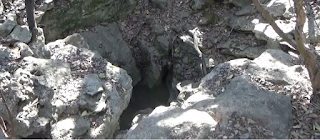Deer Park Cave is one of the lesser known caves in South Austin that not many people know about or even aware of. This is one of the few caves in Austin that are not gated. This news article will describe the geology, biology, and natural wildlife of Deer Park Cave. 


Deer Park Cave is hidden by a subdivision and a cluster of oak trees, mesquite branches, and cedar brakes. Part of this cave is enclosed by a fence. One would never expect that there would be a cave behind this fence and subdivision. Deer Park Cave is notable for having a wide entrance, small crawlspace on the inside, and narrow size on both sides.
In order to access Deer Park Cave, you have to climb a steep rocky slope that leads to a narrow cave entrance. The rugged terrain is difficult for anyone to navigate through. You need to climb a steep slope through a small maze of boulder in order to access this cave. Navigating through these boulders can be quite challenging as there is a steep rugged terrain in both directions. 

Wear proper hiking gear as both sections of this whole cave are dangerous due to the uneven rocky steep terrain. Climb with at least one person or climb with a group of 3 people and more. Be careful of the steep rugged terrain.
Now this cave is best to explore from the outside due to its narrow size and small crawlspace. However entry and accessibility into Deer Park Cave is quite easy as the low distance above ground level makes spotting this cave an easy task for many people. Deer Park Cave is easy to access overall.
The perimeter of Deer Park Cave is 20 feet wide going across in both directions. The entrance to Deer Park Cave goes down to a steep length of 12 feet. This entrance can be seen above ground when exploring the area and perimeter.
The inside of Deer Park Cave so small and cramped to the point where only 3 people can go in at a time. The inside of Deer Park Cave extends to 3 feet before hitting a dead end.

Deer Park Cave was formed out of all natural limestone and calcite. The primary type of rock formation you will expect to see inside and outside of this cave is native limestone as many caves in Central Texas have a rock formation of native limestone. Fine silt covers the floor in some areas as this cave is covered with limestone. There is no calcite breakdown though. Deer Park Cave not connected to a series of connected caves.


No natural elements were found on the inside perimeter or outside perimeter either. Not even iron ore deposits can be discovered.
Deer Park Cave has no signs of wildlife whatsoever. No wildlife can be seen inhabiting this cave. Not even insects inhabit this cave. Shrubbery does not grow within this cave. However there are several cedar brakes, oak trees, cactus, and mesquite branches on the outside near this cave. The outside view at the entrance is beautiful as you are surrounded by cedar brakes, oak trees and mesquite branches.


Deer Park Cave was named after Deer Lane which once served as Davis Lane prior to road re-alignment in 2007. Deer Park Cave also named after the Goat Cave Karst Preserve which is also a park owned by the City of Austin. That is how this cave had received the name “Deer Park Cave”.
Deer Park Cave is located at the address of 4213 Davis Lane, Austin, Texas, US 78749.






No comments:
Post a Comment